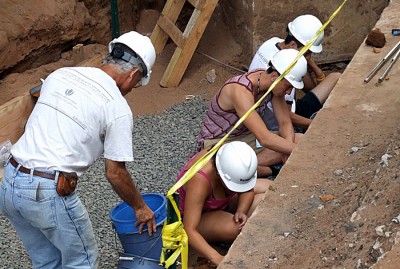
UConn archaeology professor Nick Bellantoni had just met his three charges, high school juniors participating in UConn Mentor Connection who chose to spend the three-week program working with the State Archaeologist, when an aide told Bellantoni the New Haven police were on the line, looking for him. A skeleton had been found at a construction site in the Elm City, and they wanted Bellantoni to extricate it.
Welcome to the field of archaeology.
“It was quite an orientation to archaeology,” Bellantoni said Friday, as he and the students were packing up their equipment in New Haven, preparing to return to
UConn. “I had just met them, talked to them maybe 15 to 20 minutes, when the call came. It was quite a change of plans.”
Within minutes he and the students he is mentoring – Anthony Sposato of Plainfield, Rebecca Romero of Meriden, and Nelson Merchan of Danbury – were on their way to New Haven. By week’s end, they had uncovered not one but four skeletons that Bellantoni estimates are about 100 years old.
“I’m sure every day isn’t going to be like that,” says Sposato. “I signed on with Dr. Bellantoni because I thought it would be a good way to explore archaeology as a career, but I wasn’t expecting anything like this.”
Merchan says, “When I signed up I thought I’d just be helping out, handing him [Bellantoni] tools. But when we got to New Haven he told us to go ahead and work on the bones. I was surprised. It was a really good experience. We were in there helping uncover the skeletons. He trusted us, which is pretty cool.”
Mentor Connection, funded in part by a grant from the state Department of Education and a significant endowment gift from former UConn trustee William Berkley, was launched in 1996 to help talented high school students sort out their academic interests and prepare for college life. It was also intended to encourage such students to make UConn their first choice when applying to college. Each year since its creation, about 80 rising juniors and seniors have spent three weeks on the UConn campus, living in dorms, eating in campus dining halls, and working with faculty and staff mentors. Generally, each mentor is assigned between two and five students.
The program is run by the Neag Center for Gifted Education and Talent Development in the Neag School of Education.
For Bellantoni, the discovery was just another day’s work. Records appear to indicate the site was a burial ground located behind the old Christ Church, the first Roman Catholic church in New Haven, he says. Built in 1835, the church burned down in 1848, and was rebuilt as St. John’s Evangelical Church. Bellantoni says nails found amid the skeletons indicate they were buried between 1830 and 1860.
Now unearthed, he says the skeletons will be analyzed by scientists at Yale, then reburied. As for his students, they’ll have a story for the ages.
 Facebook
Facebook
 Twitter
Twitter
 LinkedIn
LinkedIn
